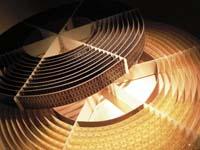Metamaterials: surprising characteristics and interest

Ingeniaritza Elektrikoa eta Elektronikoa Departamentua
Nafarroako Unibertsitate Publikoa

The research of metamaterials began with works by Yablonovich and others. They observed periodic three-dimensional structures that prevented the propagation of waves of certain frequencies. Later, Pendry and Smith experimentally demonstrated the behavior of environments with negative indexes, announced by Veselago in 1968, and since then the subject has gained great relevance. It has become one of the most intense research fields in the field of applied electromagnetism, optics and the theory of condensed matter.
Environments with negative index, also called “left environments”, present one of the most striking characteristics among metamaterials: negative refraction. To achieve this, it is necessary that the metamaterial present a negative refractive index, for which the material must have simultaneously two negative characteristics: the dielectric permissibility ( ) -- measure of the polarization that the material suffers from an electric field - and the magnetic permeability ( ) -- measure of the magnetization that the material suffers from a magnetic field --. For the first experimental test, Pendry and Smith used a medium formed by metal rings and filaments that allowed obtaining the aforementioned phenomenon.
Superlenses Lenses Superlenses Superlenses Lenses
Of the possible applications of metamaterials, the so-called superlens is the one that is generating the most interest. This is because it allows to obtain a resolution superior to the diffraction limit of the lens.
On a normal lens the resolution is limited by the wavelength, details smaller than the wavelength are lost, are not visible. These details depend on the evanescent zones, whose amplitude decreases drastically as it moves away from the source of the area. Therefore, we lose the information that the fields carry. In the superlenses, on the contrary, the amplitude of the evanescent zones increases with the distance and it is possible to recover the details. We can know the initial values of the field and therefore recover the details of the image.
If this type of superlens could be built, it would have many applications in lithography, optical storage, near area spectroscopy and in the field of medical imaging. However, the experiments carried out so far have shown that the inevitable losses degrade the behavior of the lenses and the results have not been as spectacular as was announced.
The star application of metamaterials, or at least the one that is having the greatest media echo, is the possibility of hiding objects and making them invisible. For this purpose, it is proposed to group the object with a non-homogeneous metamaterial whose permissibility and permeability characteristics would prevent an electromagnetic wave from being reflected in it, which would also be reconstructed on the other side of the object. Consequently, the object would be invisible. Its use in radars, besides other frequency bands, is the most promising. However, in the systems presented so far, invisibility is limited to a few frequencies and to a certain polarization, which reduces its usefulness in practice.
The most advanced radio waves
Radio wave applications are likely to have reached the highest maturity level. XX. The theoretical and experimental research of these wavelengths has been collected in scientific literature since the early twentieth century in the field of periodic and artificial media. However, the practical use of metamaterials and their grounded ideas have allowed to develop new component design strategies, reduce size, increase functionalities and improve the characteristics of antennas and microwave circuits.
Specifically in the field of antennas, metamaterials are being used primarily to improve their characteristics and reduce their size. In fact, the use of substrates and superlayers made with metamaterials allows to reduce couplings between antennas and improve the behavior of each antenna when they are part of the array of antennas. In addition, superstrategials based on materials to the left allow to obtain an effect equivalent to a lens and increase the antenna gain. As for the miniaturization of the antennas, efficient environments of high dielectric constant can be created at a much smaller size.
These advances generate great optimism, but it must be said that research is still in the initial phase of testing of the concept itself. And the scientific community continues to have great challenges to overcome this situation and generate metamaterials that can be used in real systems. In any case, despite the fact that these materials were not materialized, the research carried out in this field has already represented a change in the approach of the observation of certain phenomena that will be of great use in later advances.






